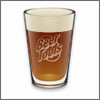kal
Well-Known Member
Been playing around with a recipe for an American style Barleywine based on Jamil's version from the Brewing Classic styles book:

19-C American Barleywine
Pre-boil amount: 13.9 gal
Post boil amount: 12.0 gal
Mash efficiency: 92.0%
Yeast attenuation: 81.0%
Original Gravity: 1.116 (style: 1.080 - 1.120)
Terminal Gravity: 1.022 (style: 1.016 - 1.030)
Color: 15.25 (style: 10.0 - 19.0)
Alcohol: 12.55% (style: 8.0% - 12.0%)
Bitterness: 101.1 (style: 50.0 - 120.0)
Ingredients:
36.5 lb Standard 2-Row (87.1% of grain bill)
1.6 lb Corn Sugar (3.8% of grain bill)
1.9 lb Cara-amber 27L (4.5% of grain bill)
1.9 lb Crystal 90L (4.5% of grain bill)
4.5 oz Magnum (14.4%) - added during boil, boiled 60.0 min
2.0 oz Chinook (11.4%) - added during boil, boiled 0.0 min
3.0 oz Centennial (9.2%) - added during boil, boiled 0.0 min
3.0 oz Amarillo (8.6%) - added during boil, boiled 0.0 min
48 g Fermentis Safale US-05
Notes:
Mash at 1.25 qt/lb
Campden tablet to tap water.
Single infusion mash at 149F for 90 mins.
Boil 60 mins.
Aerate well. Ferment at 65-68F.
I dropped the small addition (0.25 lbs per 6 gal) of Pale Chocolate malt and Special B (since I don't have any) and the other Crystals are approximations.
It's slightly too high in ABV to fit the style but hey, that's Jamil's recipe and I'm already brewing 9% IIPA's so I want this one to be at the upper end of the style.
The 40.3 lbs of grain at a mash thickness of 1.25qt/lb is about the max that my mash tun can handle too from my math (Blichmann 20 gallon pot filled to 75%).
I haven't thought too much about water treatment for this one yet but I'll probably target Moser's Ideal Pale Ale numbers as this one's along the same style idea as an APA/IPA/IIPA right?
I'll probably dry hop too with about 2 oz per 6 gallons (using some of the same of the 0 min addition hops (Chinook/Centennial/Amarillo). I'm surprised that Jamil's recipe doesn't have any dry hops. I figured that would almost be a requirement for an American Barleywine style no?
I'll ferment to completion and let it settle out in the primary for about a 3-4 weeks and then either rack to 5 gallon carboys or kegs where it'll sit for at least 9-12 months before it's consumed.
Thoughts?
Kal

19-C American Barleywine
Pre-boil amount: 13.9 gal
Post boil amount: 12.0 gal
Mash efficiency: 92.0%
Yeast attenuation: 81.0%
Original Gravity: 1.116 (style: 1.080 - 1.120)
Terminal Gravity: 1.022 (style: 1.016 - 1.030)
Color: 15.25 (style: 10.0 - 19.0)
Alcohol: 12.55% (style: 8.0% - 12.0%)
Bitterness: 101.1 (style: 50.0 - 120.0)
Ingredients:
36.5 lb Standard 2-Row (87.1% of grain bill)
1.6 lb Corn Sugar (3.8% of grain bill)
1.9 lb Cara-amber 27L (4.5% of grain bill)
1.9 lb Crystal 90L (4.5% of grain bill)
4.5 oz Magnum (14.4%) - added during boil, boiled 60.0 min
2.0 oz Chinook (11.4%) - added during boil, boiled 0.0 min
3.0 oz Centennial (9.2%) - added during boil, boiled 0.0 min
3.0 oz Amarillo (8.6%) - added during boil, boiled 0.0 min
48 g Fermentis Safale US-05
Notes:
Mash at 1.25 qt/lb
Campden tablet to tap water.
Single infusion mash at 149F for 90 mins.
Boil 60 mins.
Aerate well. Ferment at 65-68F.
I dropped the small addition (0.25 lbs per 6 gal) of Pale Chocolate malt and Special B (since I don't have any) and the other Crystals are approximations.
It's slightly too high in ABV to fit the style but hey, that's Jamil's recipe and I'm already brewing 9% IIPA's so I want this one to be at the upper end of the style.
The 40.3 lbs of grain at a mash thickness of 1.25qt/lb is about the max that my mash tun can handle too from my math (Blichmann 20 gallon pot filled to 75%).
I haven't thought too much about water treatment for this one yet but I'll probably target Moser's Ideal Pale Ale numbers as this one's along the same style idea as an APA/IPA/IIPA right?
I'll probably dry hop too with about 2 oz per 6 gallons (using some of the same of the 0 min addition hops (Chinook/Centennial/Amarillo). I'm surprised that Jamil's recipe doesn't have any dry hops. I figured that would almost be a requirement for an American Barleywine style no?
I'll ferment to completion and let it settle out in the primary for about a 3-4 weeks and then either rack to 5 gallon carboys or kegs where it'll sit for at least 9-12 months before it's consumed.
Thoughts?
Kal



